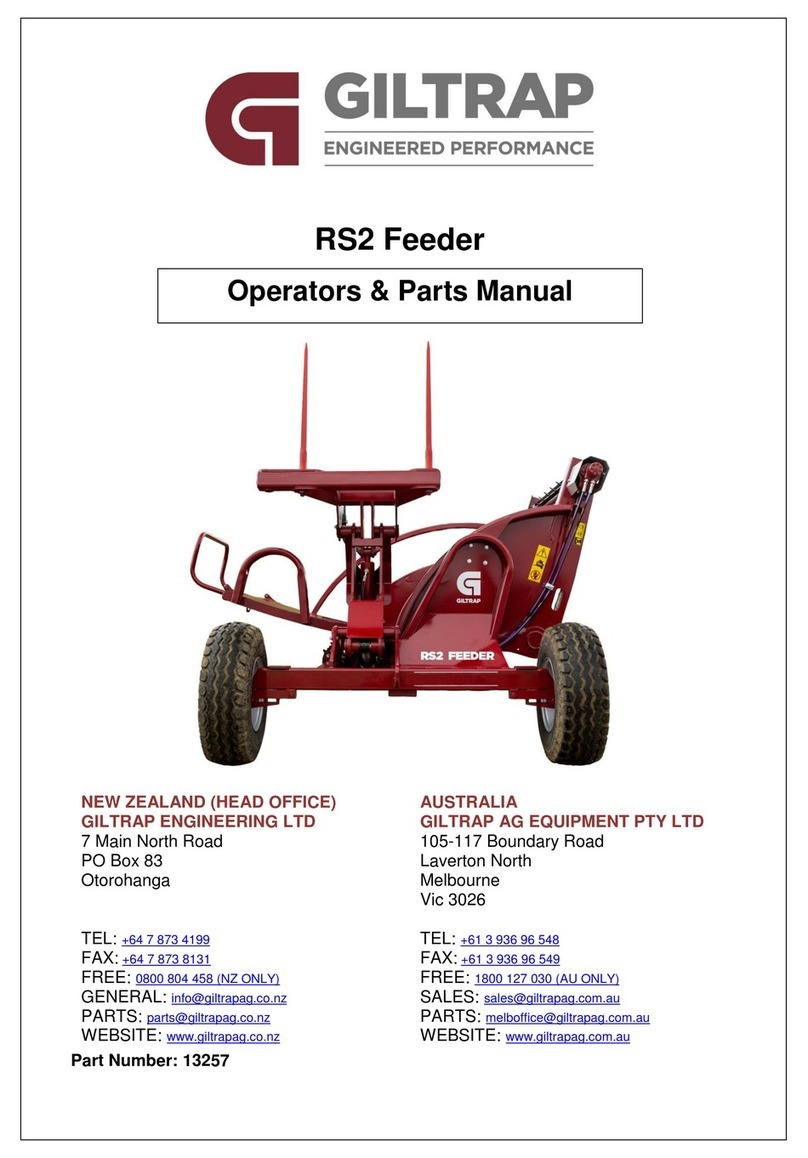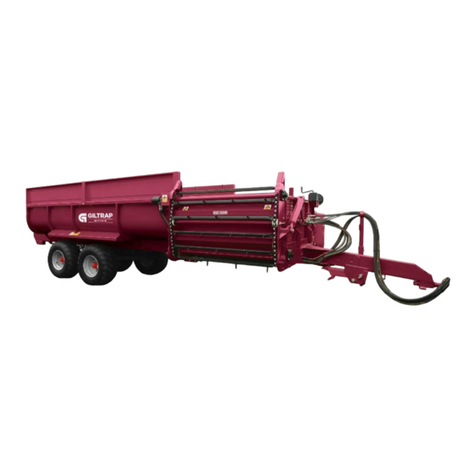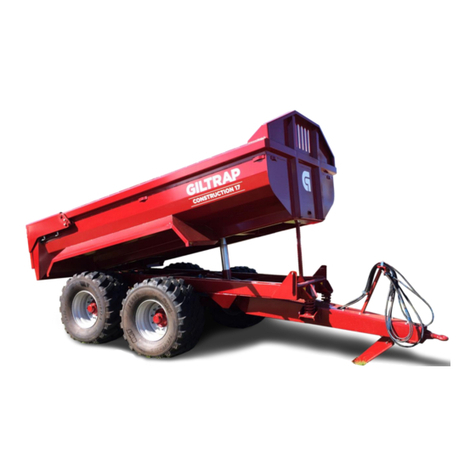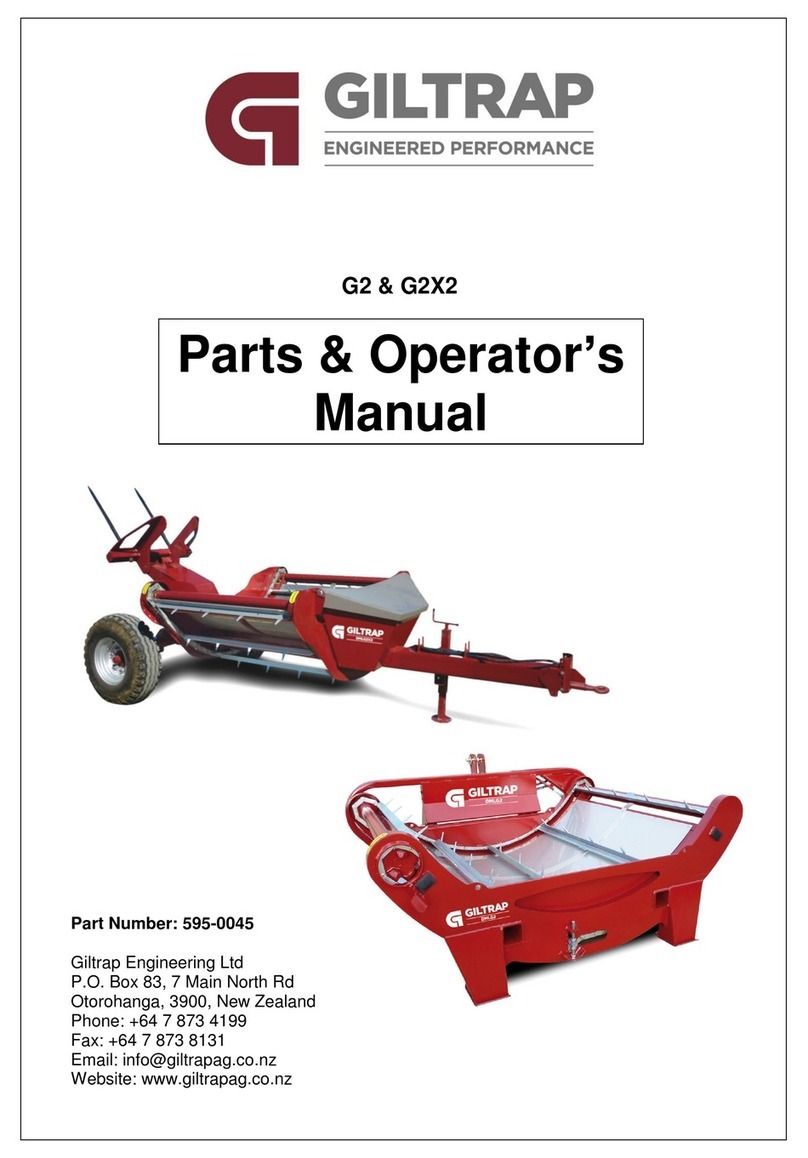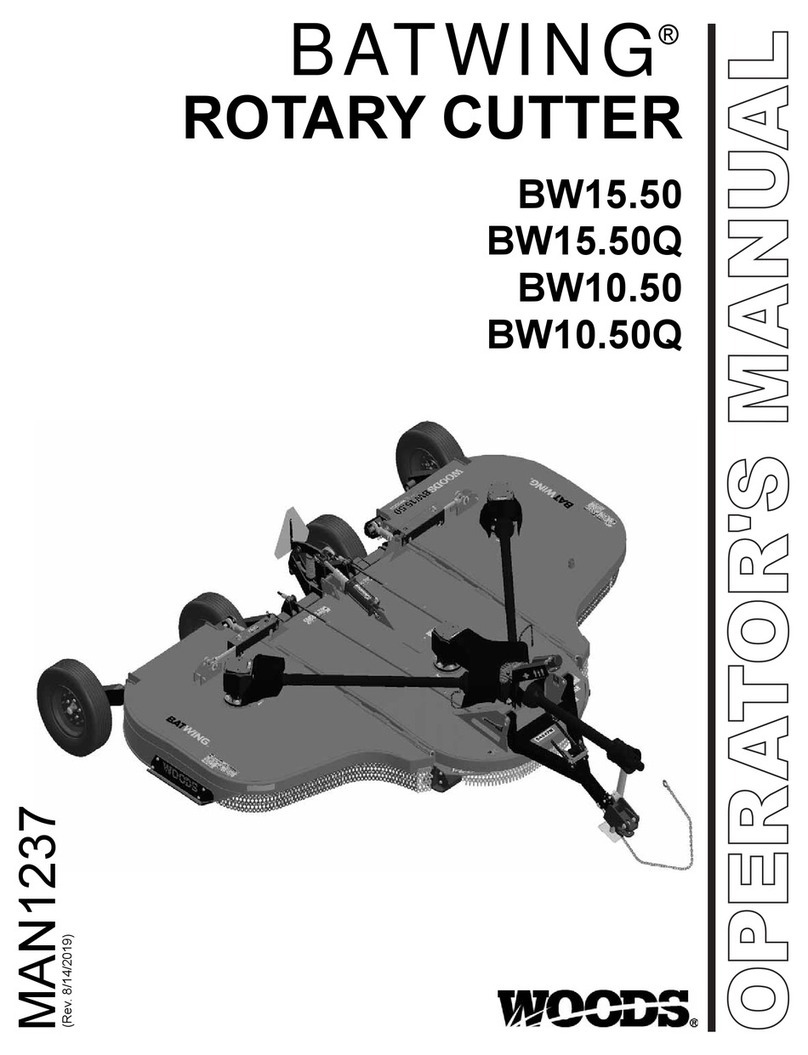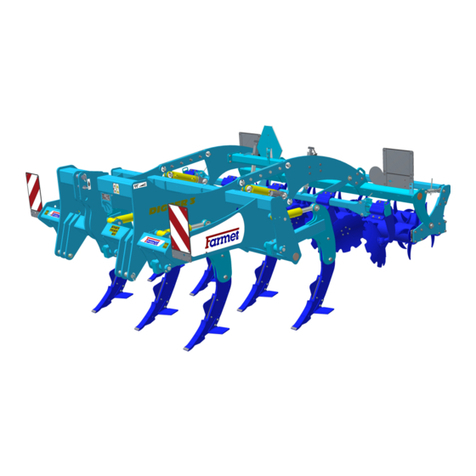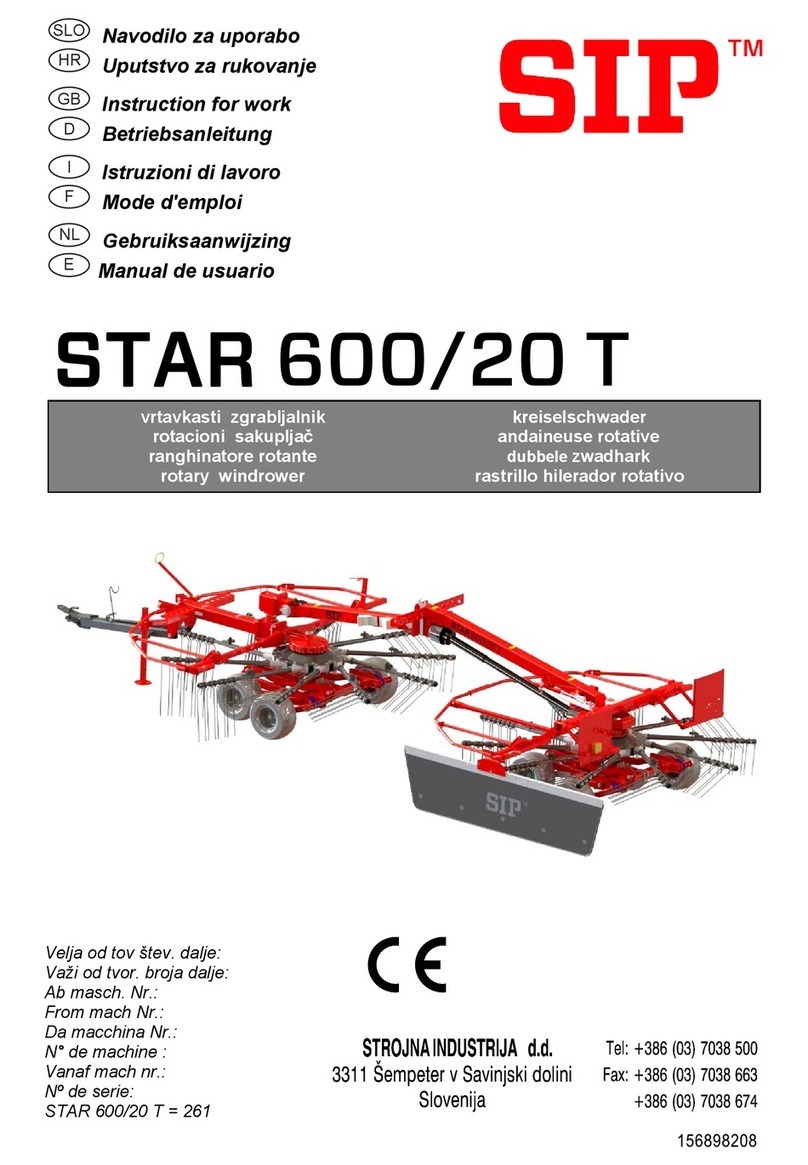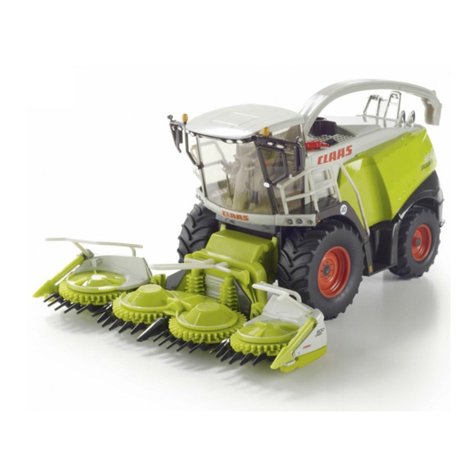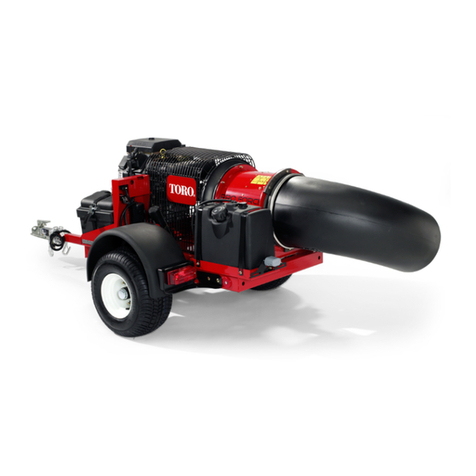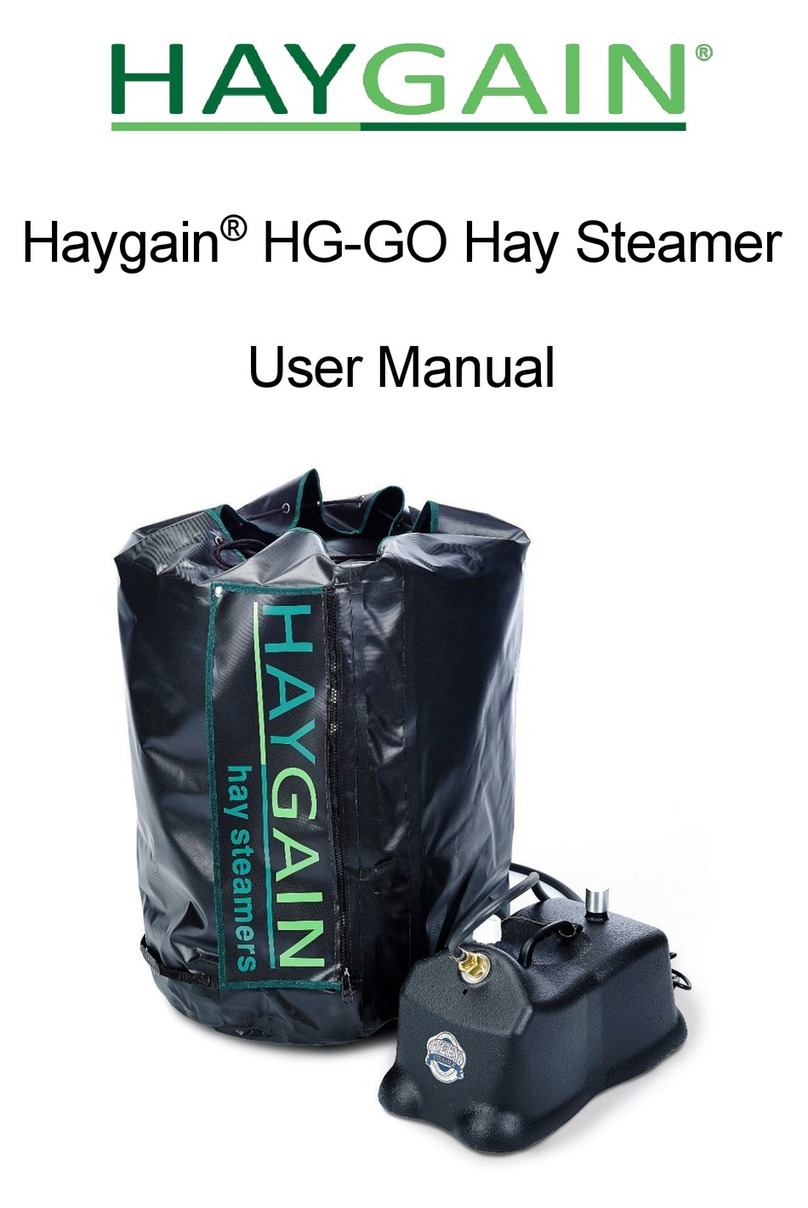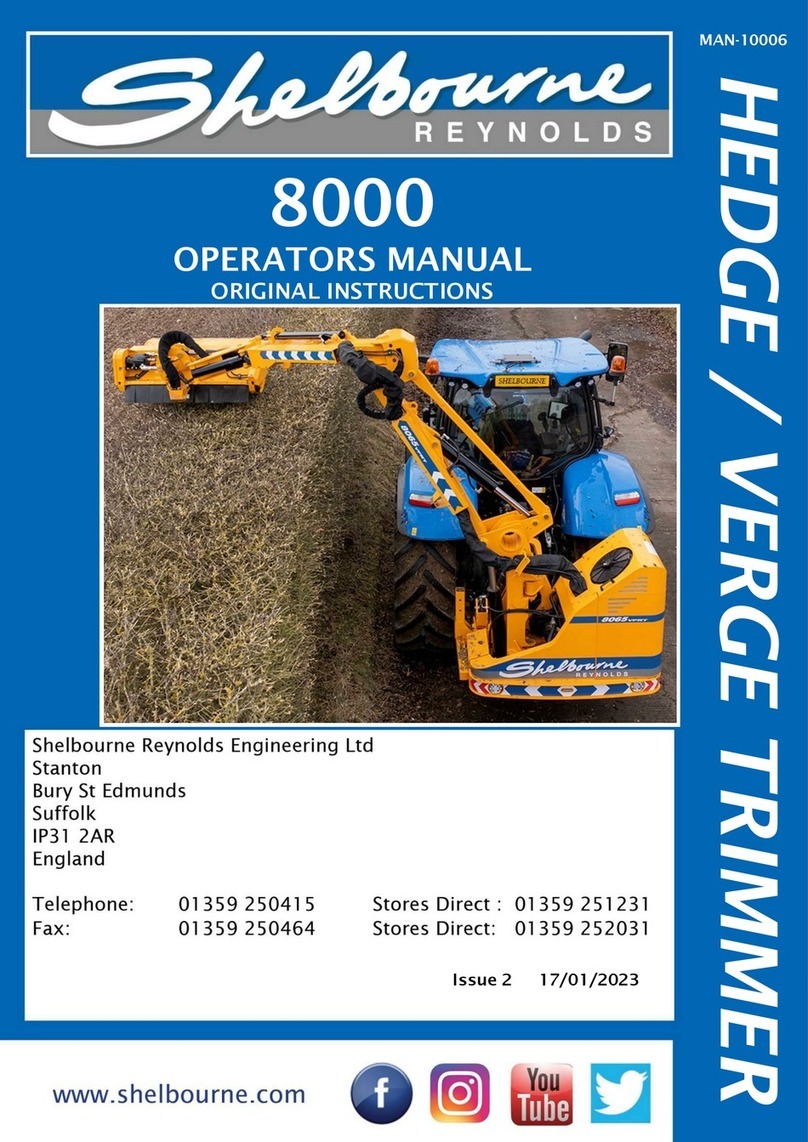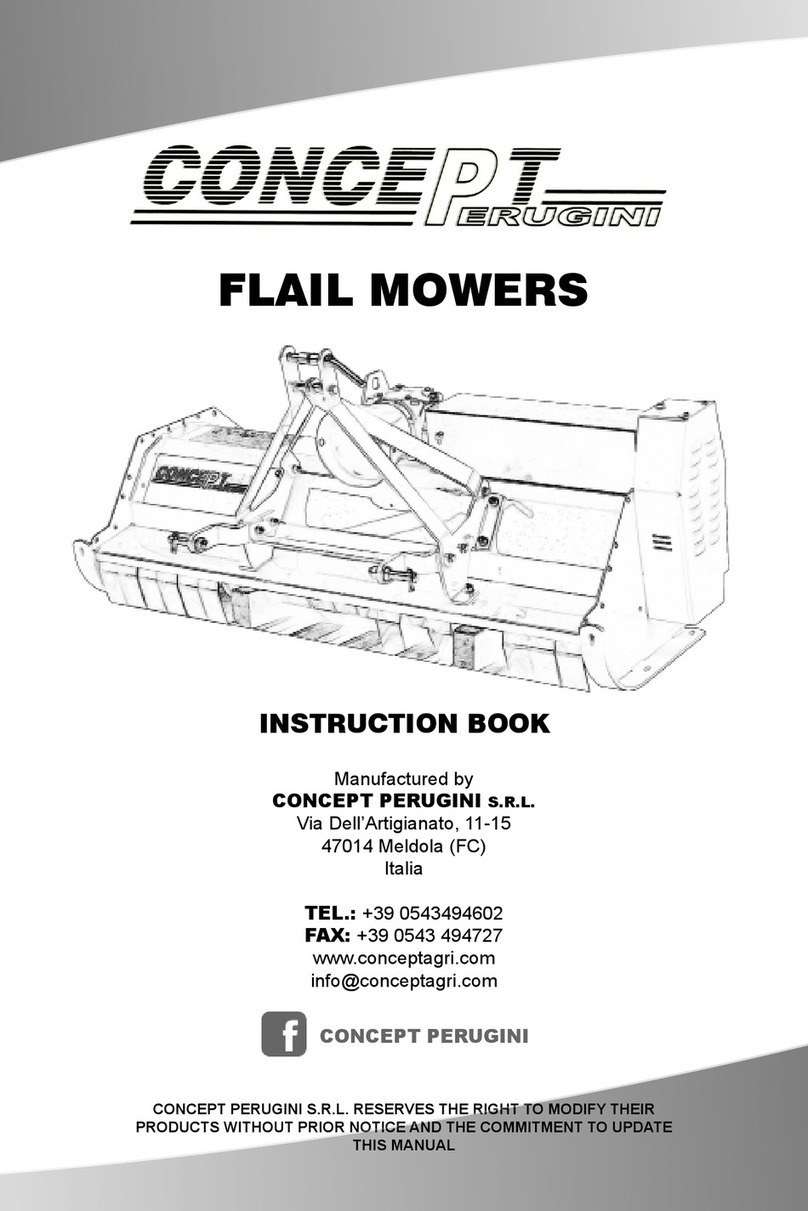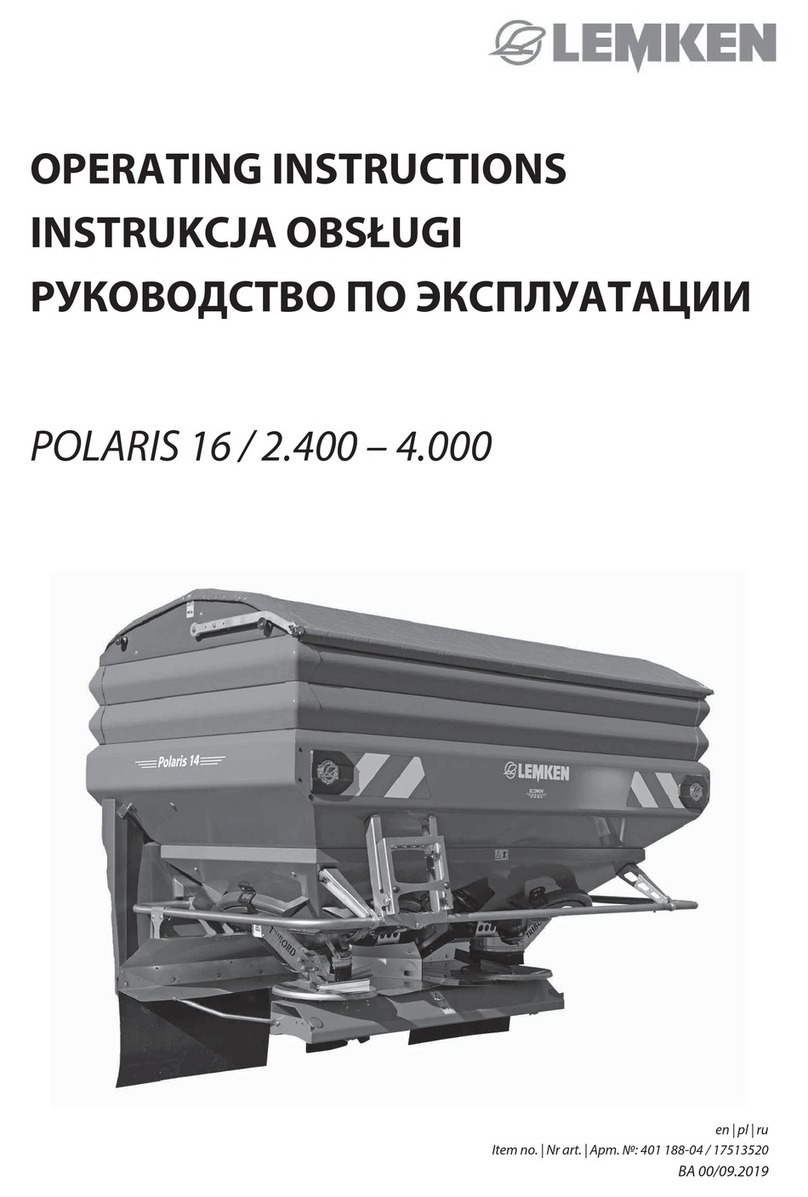Giltrap Bale Buggy Programming manual

Part Number: 13481
Bale Buggy
Operators & Parts
Manual
AUSTRALIA
GILTRAP AG EQUIPMENT PTY LTD
105-117 Boundary Road
Laverton North
Melbourne
Vic 3026
TEL: +61 3 936 96 548
FAX: +61 3 936 96 549
FREE: 1800 127 030 (AU ONLY)
SALES: sales@giltrapag.com.au
PARTS: [email protected]
WEBSITE: www.giltrapag.com.au
NEW ZEALAND (HEAD OFFICE)
GILTRAP ENGINEERING LTD
7 Main North Road
PO Box 83
Otorohanga
TEL: +64 7 873 4199
FAX: +64 7 873 8131
FREE: 0800 804 458 (NZ ONLY)
GENERAL: [email protected]
PARTS: parts@giltrapag.co.nz
WEBSITE: www.giltrapag.co.nz

Bale Buggy –Operator’s Manual & Parts Book
Page 2
Disclaimer
Although every endeavour has been made to compile as near to complete records as
possible for the machine described, it is possible some information is incomplete or
missing.
Giltrap Engineering request that you treat this book as a guide only, and offer any
assistance necessary to procure the information or part you may require.
For parts or service enquiries, please contact the applicable numbers on the previous
page.
Produced June 2020
Copyright 2020 by Giltrap Engineering Ltd.
Printed in New Zealand
All rights reserved. Reproduction or use, without express permission, of editorial or pictorial content, in any manner, is prohibited.

Bale Buggy –Operator’s Manual & Parts Book
Page 3
Table of Contents
INTRODUCTION ...................................................................................................................................................... 4
DELIVERY ................................................................................................................................................................. 4
DESCRIPTION OF MACHINE................................................................................................................................ 5
WORKING PRINCIPLE........................................................................................................................................... 5
FEATURES................................................................................................................................................................. 5
SPECIFICATION....................................................................................................................................................... 5
WARRANTY .............................................................................................................................................................. 6
CLAIMS ...................................................................................................................................................................... 7
SAFETY - GENERAL................................................................................................................................................ 8
SAFETY –MACHINE SPECIFIC ......................................................................................................................... 11
SETUP & OPERATING INSTRUCTIONS........................................................................................................... 12
LOADING INSTRUCTIONS ......................................................................................................................................... 12
FEEDING OUT .......................................................................................................................................................... 12
MAINTENANCE...................................................................................................................................................... 13
GREASING................................................................................................................................................................ 13
FREQUENCY............................................................................................................................................................. 13
STROPS .................................................................................................................................................................... 13
TYRES...................................................................................................................................................................... 14
FASTENERS.............................................................................................................................................................. 14
MECHANICAL ADJUSTMENTS.......................................................................................................................... 14
DRIVE CHAIN ADJUSTMENT .................................................................................................................................... 14
FLOOR CHAIN ADJUSTMENT.................................................................................................................................... 14
DRIVE WHEEL ADJUSTMENT ................................................................................................................................... 14
STORAGE................................................................................................................................................................. 15
PARTS SECTION .................................................................................................................................................... 16
CHASSIS................................................................................................................................................................... 17
CRADLE................................................................................................................................................................... 18
DRIVE MECHANISM ................................................................................................................................................. 19
CHAIN VIEW............................................................................................................................................................ 20
WHEEL HUB ............................................................................................................................................................ 21

Bale Buggy –Operator’s Manual & Parts Book
Page 4
Introduction
Thank you for purchasing a Giltrap product. Giltrap Engineering Ltd has enjoyed a long-standing success
with their machinery. We would like you to enjoy the benefits of owning a Giltrap too. By following the
guidelines laid out in this book, you will ensure trouble free, low maintenance operating for years.
Giltrap Engineering Ltd is a progressive company that continually strives to satisfy your needs, so we
welcome any feedback which you can provide to help us improve our products and services and to
ensure that they perform to your expectations. Any constructive comments about this operator’s
manual are also welcome.
Your machine has been designed to perform its task efficiently and with a minimum of maintenance.
This handbook provides safety guidelines, instructions, maintenance requirements and parts listings.
We recommend that you read the entire handbook, before operating the machine as this will enable
you to take full advantage of your new machine’s considerable potential.
Delivery
Before you begin to use your machine, please check it to make sure there is no delivery damage. If
damage is evident, contact the dealer who supplied the machine so that they can make the appropriate
claims.
If you have any other queries, please contact your dealer or Giltrap Engineering Ltd (0800 80 GILTRAP).
All Giltrap products are covered by a 36 month warranty (see next page) on parts and labour, subject to
normal use.
Please fill in the details below for future reference.
Model:
Serial No:
Delivery Date:
Dealer:

Bale Buggy –Operator’s Manual & Parts Book
Page 5
Description of Machine
The Giltrap Bale Buggy is a rear feeding, single bale ATV feeder. It is designed to handle all types of
round bales. The buggy is ground driven and is designed to feed without making mud in the pasture
because the unit does not need to be towed by a tractor.
Working Principle
The machine is self loading by means of a boat winch and bale hooks (no hydraulics). It can be towed by
an ATV, four-wheel-drive farm ute or any other form of farm vehicle to suit the terrain or conditions.
Features
· Feeds out the rear, giving the advantage of preventing material blockage in the chains.
· Handles all types of round bales.
· 8 mm high-tensile link feed chains.
· Geared three times slower than ground speed, which gives the advantage of not leaving a continuous
mat of feed. This also prevents the ground drive wheel from slipping in the mud.
· The bale’s weight is always forced forward in the machine when feeding, for two reasons:
1. To keep weight on the drawbar for traction on an ATV.
2. When going up a hill it eliminates the risk of the bale falling off the back.
Specification
Dimensions & Capacities
Bale Size (Max): 1800 mm dia. x 1350 mm
Weight (unladen): 310 kg
Weight (Maximum Laden): 1300 kg
Height: 1520 mm
Length: 3400 mm
Width: 2150 mm

Bale Buggy –Operator’s Manual & Parts Book
Page 6
Warranty
Subject as hereunder provided, Giltrap Engineering Limited (Hereafter called the Seller) undertake to
correct either by repair, or at their election, by replacement, any defect of material or workmanship
which occurs in any of its goods within twenty four months after delivery of such goods to a first user,
with the exception of contractors or commercial users when the warranty period is limited to six
months.
In addition to the primary 24 month warranty, the Seller undertake to correct either by repair, or at
their election, by replacement, any defect of material or workmanship which occurs in any structural
assembly in any of its goods within thirty six months after delivery of such goods to a first user, with the
exception of contractors or commercial users when the warranty period is limited to six months.
The term goods when used in this document means the article or articles described in invoice as sold by
the Seller but does not include equipment or proprietary parts or accessories not manufactured by the
Seller. The Seller, however, undertakes to pass on so far as they legally can to the first user the benefit
of any warranty given to the Seller by the suppliers of such equipment, parts or accessories.
This understanding shall not apply to:
Any goods which have been sold by the first user.
Any goods which have been damaged by unfair wear and tear, neglect or improper use.
Any goods the identification marks of which have been altered or removed.
Any goods, which have not received maintenance as, set out in this book also such basic normal
maintenance such as tightening of bolts, nuts, hose connections and fittings and normal
lubrication with the recommended lubricant.
Any goods which have been altered or repaired other than on instruction or with the written
approval of the Seller or to which any part not manufactured or having written approval by the
Seller has been fixed.
Any second-hand goods or part thereof.
Any allegedly defective part or parts returned to the Seller must be sent freight paid. No claim for repair
or replacement will be entertained unless, upon discovery of the alleged defect written notification is
sent to the Seller, giving at the same time, the name of the Buyer from whom the goods were purchased
and the date of purchase, together with full details of the alleged defect and the circumstances involved,
and also the serial number of the machine.
The Seller shall not be under liability to their Buyers and first and subsequent users of their goods or to
any other person or persons for loss or damages howsoever arising in respect of either personal injuries
or for special or consequential damage of any kind or from any cause whatsoever arising out of, or in
any way connected with or arising from the manufacture, sale, handling, repair, maintenance,
replacement or use of its goods or the failure or malfunction of any of its goods. Representation and/or
warranties made by any person (including Buyers and employees and other representatives of the
Seller) which are inconsistent or conflicting with these conditions are not binding upon the Seller unless
given in writing and signed by a Director of the Seller.

Bale Buggy –Operator’s Manual & Parts Book
Page 7
Claims
If you wish to make a claim under warranty:
Immediately stop using the machine.
List details of the machine and damaged item including serial numbers and date of purchase.
Consult with your Giltrap dealer (supplier) and have him forward your claim and the damaged
item to Giltrap Engineering Ltd.
No warranty to be undertaken unless an order number is obtained from the Seller (Giltrap
Engineering Ltd) prior to any work being done.

Bale Buggy –Operator’s Manual & Parts Book
Page 8
Safety - General
This section of the manual offers general guidelines for the safe operation of machinery.
It does not replace local safety regulations. These guidelines were current at the time of publication, but
may be superseded by later regulations.
Giltrap Engineering has made every effort to highlight all risks to personnel or property. Owners and
operators have a responsibility to exercise care and safe work practices at all times in the vicinity of the
machine.
Owners are advised to keep up to date on safety issues and to communicate these to all users of the
machine.
Contact the Occupational Safety and Health Service (OSH) for further information about general safety
aspects. If you have safety concerns specifically related to this machine, contact your dealer
immediately.
Operator Safety
Read this manual carefully before operating new equipment. Learn how to use this machine safely. Be
thoroughly familiar with the controls and the proper use of the equipment before using it. Take careful
note of all safety instructions both in this manual and on the machine itself. Failure to comply with
instructions could result in personal injury and/or damage to the machine. Replace missing or damaged
safety signs on the machine and ensure that these remain clearly visible.
It is the owner’s responsibility to ensure that anyone who operates, adjusts, lubricates, maintains,
cleans or uses the machine in any way has had suitable instruction and is familiar with the
information in this manual (particularly with regard to safety aspects).
Operators and other users of the machine should be aware of potential hazards and operating
limitations.
Be Prepared for Emergencies
Keep a first aid kit and fire extinguisher handy. Keep emergency numbers for doctors, ambulance,
hospital and fire department near your telephone.
Appropriate Dress
Wear close fitting clothing and avoid rings or other forms of jewellery which could become caught in the
machinery.
People with long hair must have it securely fixed and confined close to the head.
Refer to local safety standards for protective clothing and recommended safety equipment.
Adequate protection, such as a face mask, should be worn if operating this machine in dry and dusty
conditions.
Transport This Machine Safely
Ensure that all linkage pins and security clips are fitted correctly.
With trailing machines tow with the drawbar only, as this is the only safe towing point on the machine.
Always check that bystanders (especially children) are well clear (front and rear) before starting and
moving the tractor and the machine.

Bale Buggy –Operator’s Manual & Parts Book
Page 9
Plan safe routes of travel, and be aware of power lines and other roadside hazards.
Take particular care when towing implements on hillsides.
Do not ride or allow passengers on the machine. This machine is not designed to carry passengers, and
no riders are permitted.
Road transport
On public roads,
A speed of 40km/h must not be exceeded.
Do not operate during the hours of darkness unless standard lights are fitted and clearly visible.
(This also applies when visibility is limited, e.g., in foggy conditions.)
See the guidelines in the Vehicle Dimensions and Mass Rule issued by the Land & Transport Safety
Authority.
Avoid tip-overs
Run the machine along hillsides with the elevator on the high side of the hill. Avoid holes, ditches and
obstructions which may cause the machine to tip over, especially on hillsides. Never drive near the edge
of a gully or steep embankment - it might cave in. Slow down for hillsides, rough ground and sharp
turns.
Handle Agricultural Chemicals Safely
All farm chemicals should be stored, used, handled and disposed of safely and in accordance with the
supplier’s/manufacturer’s recommendations.
Read the product label before using, noting any warnings or special cautions, including any protective
clothing or equipment that may be required, i.e. respirator.
Do not eat or smoke while handling sprays, fertilisers, coated seeds, etc. Afterwards, always wash your
hands and face before you eat, drink, smoke, or use the toilet.
Store sprays, fertilisers, coated seeds, etc. out of reach of children and pets, and away from food and
animal feeds.
Any symptoms of illness during or after using chemicals should be treated according to the
supplier’s/manufacturer’s recommendations. If severe, call a physician or get the patient to hospital
immediately. Keep the container and/or label for reference.
Avoid High Pressure Fluids
Avoid any contact with fluids leaking under pressure, because the fluids can penetrate the skin surface.
Any fluid which penetrates the skin will need to be removed immediately by a medical expert. Seek
specialist advice on this type of injury.
Relieve the pressure before disconnecting any hydraulic or other lines. Make all repairs and tighten all
fittings before re-connection to pressurised fluid.
Keep your hands and body away from any pinholes or high pressure jets. Search for leaks with a piece of
cardboard instead of using your hand directly.

Bale Buggy –Operator’s Manual & Parts Book
Page 10
Safe Work Practices
All farm machinery is potentially dangerous and should be treated with caution and respect.
Before starting the machine, ensure that all controls are placed in neutral and that bystanders are well
clear. Check that the guards have been securely fitted and that any adjustments have been made
correctly.
Where possible, disconnect or isolate the drive mechanism to the implement. Lower the machine onto
the ground when not in use.
Do not operate this equipment when severe weather conditions appear imminent.
Practice Safe Maintenance
Keep the machine in safe working condition. Routine maintenance and regular servicing will help reduce
risks and prolong the life of the machine.
General Maintenance
Accidents occur most frequently during servicing and repair. The following general rules must be
followed when maintaining or working with machinery:
All operating and maintenance manuals must be read before and referred to while using or
servicing any piece of equipment.
Turn off all machinery power sources and isolate the machine before making adjustments, doing
lubrication, repairs or any other maintenance on the machine.
Ensure that the machine hydraulics are disconnected from the power source.
Wear gloves when handling components with cutting edges, such as any ground cutting
components.
Beware of hazards created by springs under tension or compression when dismantling or
maintaining the machine.
It is recommended that you clean the machine with a water blaster or similar apparatus before
commencing maintenance.
Make Sure the Machine is Well Supported
When machinery is fitted with hydraulics, do not rely on the hydraulics to support the machine. During
maintenance or while making adjustments under the machine, always lock the hydraulics and support
the machine securely. Place blocks or other stable supports under elevated parts before working on
these.
Electrical Maintenance
Disconnect the electrical supply from the tractor before doing any electrical maintenance.
Welding
With electronic equipment in modern tractors it is advisable to disconnect the machine from the tractor,
or at least disconnect the alternator and battery before attempting any welding.
Use Only Genuine Spare Parts
Unauthorised modifications or non-genuine spare parts may be hazardous and impair the safe operation
and working life of the machine.
Excess lubricants must be disposed of safely so as not to become a hazard.

Bale Buggy –Operator’s Manual & Parts Book
Page 11
Safety –Machine Specific
The lists below are not all-inclusive and serve only to highlight the more obvious areas of risk.
The labels attached to the machine are a general reminder that there are hazardous areas on the
machine, rather than specifically highlighting all possible hazards.
The machines have been supplied with the following warning labels. It is the user’s responsibility to keep
them in visible condition.
TPSI Bale Buggy
Pinch Points/Moving Parts
Hazardous areas include:
Lifting and lowering of Drive mechanism
Cradle dropping on to ground
Cradle dropping on to chassis
Keep Clear
Hazardous areas include:
Area between machine and tow vehicle
General area around the machine while it is
operating
Keep off machine while it is moving
Rotating Chains & Bars
Beware of moving parts
Beware of sharp points
When Loading
Ensure ratchet is engaged as shown, to prevent the
winch handle from rotating out of control
Transport
Ensure tow ball is correct size

Bale Buggy –Operator’s Manual & Parts Book
Page 12
Fig. 1
Fig. 2
Setup & Operating Instructions
Loading Instructions
1. Cut the end of the wrap away so that you can
see which way the bale has been made. If you
want a heavy feed trail, load the way it was
baled; if you require a light feed trail, then load
the opposite way.
2. When you have the bale the way you require
it, back up to within a foot of it. Cut away the
wrap and webbing or strings, and remove as
much as possible from the bale. Release the
strop at the winch and pull it and the carriage
over. Refer Fig 1
3. Pull the strop over to the far side of the bale
and set the two bale hooks as far down as
possible at both sides of the bale. Attach the
strop in the middle of the connecting chain.
Ensure the bale hooks are fully embedded in the
bale. Refer Fig 2.
4. Check that the open feeding chain is in its
plastic idlers at the bottom of the carriage and
that the chains are in line. You cannot feed a
bale with these unaligned.
5. Winch the bale and carriage into the feeding
position. When the carriage is down, remove the
strop and hooks from the bale. Wind in the strop
until tight and ensure the winch is locked with
the ratchet (refer P10) to prevent the carriage
from tipping backwards during transport or
when the bale is fed out.
You may now move safely to where you are going to feed out.
Feeding Out
1 To connect the drive, simply unlock the drive lever assembly, let it drop down to the ground wheel,
then pull firmly down until it locks in the drive position. Now you are ready to feed out your bale.
2 To feed out the bale simply drive forward and the bale will feed out behind the unit.

Bale Buggy –Operator’s Manual & Parts Book
Page 13
Maintenance
Greasing
There are 7 greasing points on the unit.
Item
Components
Lubricant
Number
1
Floor Chain Idler Sprockets
Grease
2
2
Floor Chain Drive Shaft Bearings
Grease
2
3
Winch (Gears)
Grease
1
4
Drive Chain
Suitable Roller Chain Lubricant
1
5
Jockey Wheel
Grease
1
Frequency
The required greasing frequency is dependent on the extent of use, climate and conditions.
In any situation the drive wheel should turn freely and if it does not the relevant lubrication points
should be greased. This applies to the winch and jockey wheel also.
Note: The drive chain needs lubricating with a suitable chain lubricant prior to the start of the season.
Strops
Worn strops should be checked and replaced, as wear can cause breakage under strain. It is
recommended that strops have a weekly and pre-season check.

Bale Buggy –Operator’s Manual & Parts Book
Page 14
Fig. 3
Tyres
Tyre pressure should be maintained at 12 psi. It is recommended that tyres, as a minimum, should be
inspected for damage and have the pressure checked as part of a pre-season check.
Fasteners
Check fasteners regularly to minimise likelihood of equipment damage or accident resulting from
fasteners loosening.
Check as recommended in the table below:
Item
Frequency
Tow coupling
Weekly & pre-season check
Wheel Nuts
Weekly & pre-season check
Winch
Weekly & pre-season check
Jockey Wheel
Weekly & pre-season check
All Others
Pre-season check
Mechanical Adjustments
Drive Chain Adjustment
The drive chain tension can be adjusted by releasing the chain
tensioner retaining bolt and sliding the tensioner down or up
in the groove to take up the slack in the chain. Tighten the
retaining bolt when the chain is adjusted.
Floor Chain Adjustment
To increase the floor chain tension, undo the M24 nyloc nuts
and do up the M24 plain nuts until the desired tension is
reached. Tighten up the M24 nyloc nuts to lock and secure the
chain tensioner assemblies
Drive Wheel Adjustment
To compensate for wear on the ground tyre, the pressure can
be adjusted by releasing the retaining bolts and aligning the
plates to an alternative set of holes. Secure the retaining bolts
when the adjustment has been made. See Fig. 3.

Bale Buggy –Operator’s Manual & Parts Book
Page 15
Storage
General Cleaning
Before storage water blast the machine and remove mud and excess feed which may have accumulated
during the season.
Warning: Keep well clear of the drives and floor chains while running the machine.
Lubrication
To preserve drive chains over the off-season:
1. Flush any contaminants from the chains Used hydraulic or transmission oil is ideal for this purpose.
This should be carried out after the machine has been water blasted.
2. Apply an excess amount of oil to the drive chains. Run the machine slowly and repeat this operation
until the chains are welllubricated. Remove excess oil.
Prior to the start of the season, the drive chain needs lubricating with a suitable chain lubricant. Refer
Maintenance section.

Bale Buggy –Operator’s Manual & Parts Book
Page 16
Parts Section

Bale Buggy –Operator’s Manual & Parts Book
Page 17
Chassis
Item No.
Part Number
Description
Quantity
1
43741
Winch
1
2
12912
Winch Support diagonal
1
3
43743
Trailer Coupling
1
4
12850
Bale buggy chassis
1
5
12914 (RH)
Grappling hook hanger
1
6
12911
Winch support vertical
1
7
27095
Hook Assembly
1
8
12914 (LH)
Grappling hook hanger
1
9
25x12.00-9
Bale buggy tyre
2

Bale Buggy –Operator’s Manual & Parts Book
Page 18
Cradle
Item No.
Part Number
Description
Quantity
1
13437
Right side top brace
1
2
13440
Ally Side panel (RH)
1
3
27127
Strop roller
1
4
12933
Anti wrap outer assm
2
5
43755
Bearing and housing
2
6
27125
Floor chain drive sprocket
2
7
12959
Floor chain drive shaft
1
8
12934
Anti wrap centre assm
1
9
12962
Pipe spacer
1
10
27123
21T Drive sprocket
1
11
12859
Carriage assembly
1
12
12907
Ally Side panel (LH)
1
13
12916
Plastic guard
1
14
13438
Idler support bar
1

Bale Buggy –Operator’s Manual & Parts Book
Page 19
Drive Mechanism
Item No.
Part Number
Description
Quantity
1
BB Drive Chain
Ground drive chain
1
2
13384
75mm-35mm washer
4
3
BRG6007
Bearing
8
4
12965
Drive arm assm
1
5
13385
Mainshaft Lockcap
1
6
12936
Drive wheel
2
7
12939
Drive wheel shaft and flange
1
8
12875
Drive engagement lever
1
9
12923
Roller Tensioner
1
10
12945
Latch pin
1
11
12967
Chain tensioner roller
1
12
12971
Hand lever
1
13
12926
Upper link assm
1
14
12929
Top pivot
1
15
27124
8T Drive sprocket
1

Bale Buggy –Operator’s Manual & Parts Book
Page 20
Chain View
Item No.
Part Number
Description
Quantity
1
12866-1
Two spike batten
12 per machine
2
Floor chain
2
3
12869
Chain tensioner assm
2
4
27126
Feed chain idler
2
5
12961
Idler sprocket sleeve
2
6
27128
Chain lower idler
2
Table of contents
Other Giltrap Farm Equipment manuals
Popular Farm Equipment manuals by other brands
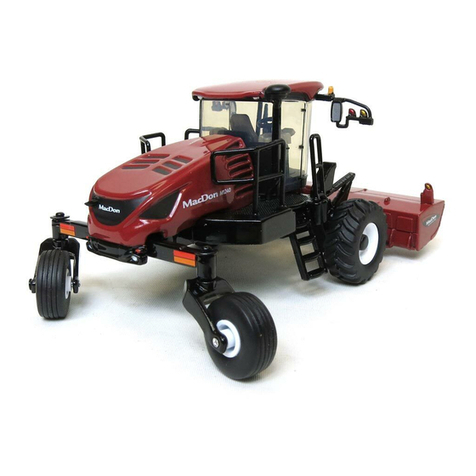
MacDon
MacDon M1240 Operator's manual
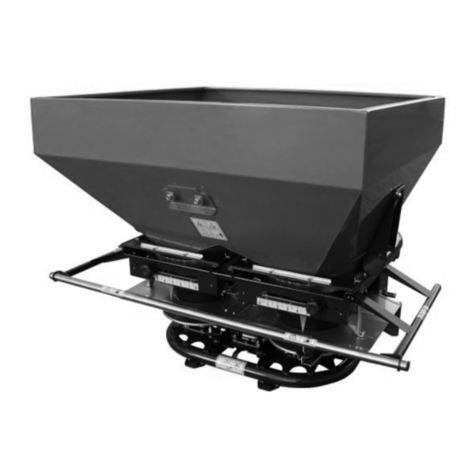
Maschio
Maschio GASPARDO CIRO E USE AND MAINTENANCE - OPERATOR'S MANUAL
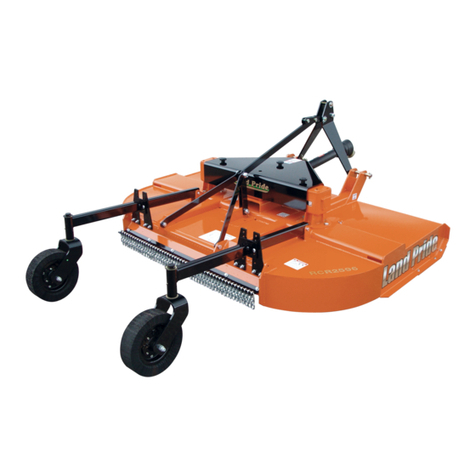
Land Pride
Land Pride RCR2596 Series Operator's manual
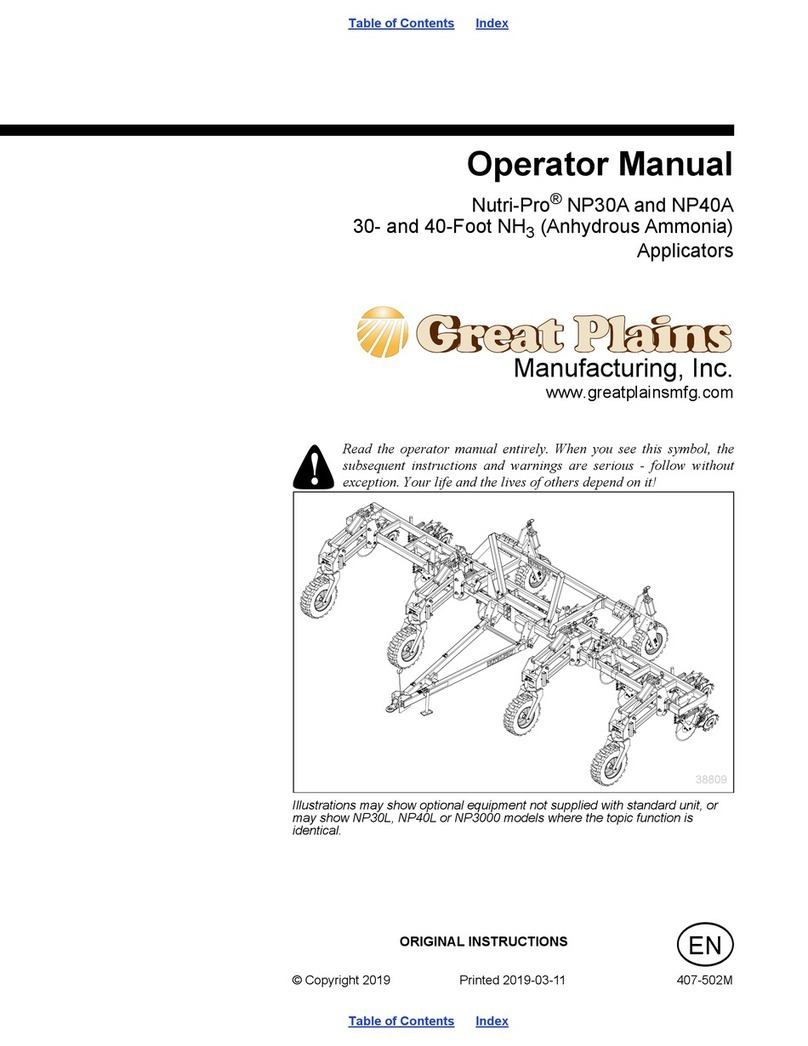
GREAT PLAINS
GREAT PLAINS Nutri-Pro NP40A Operator's manual
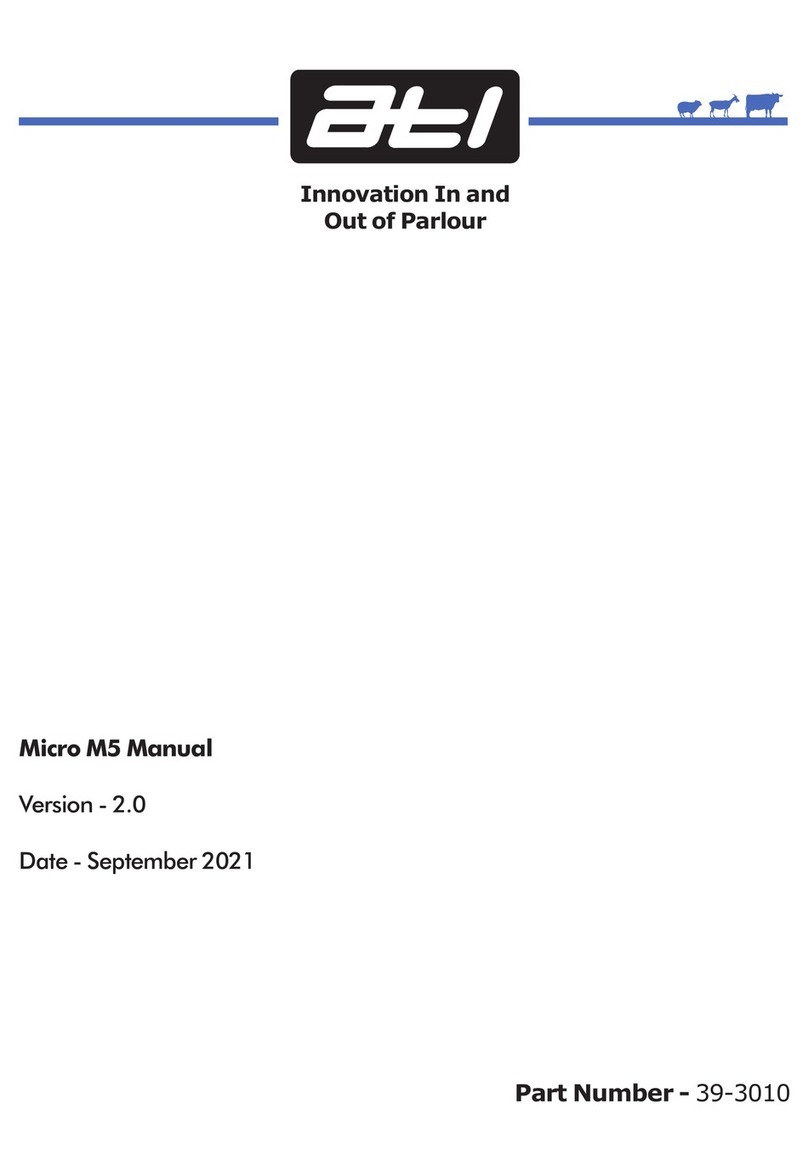
ATI Technologies
ATI Technologies Micro M5 manual
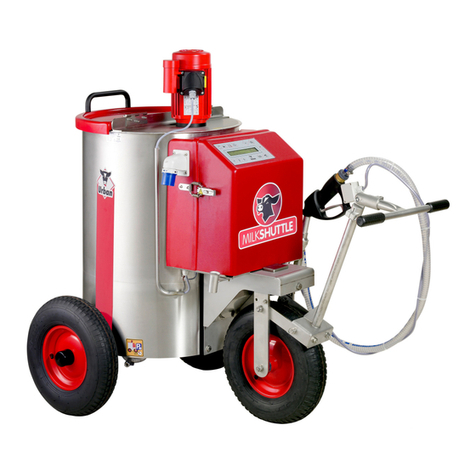
Urban
Urban MilkShuttle operating instructions
